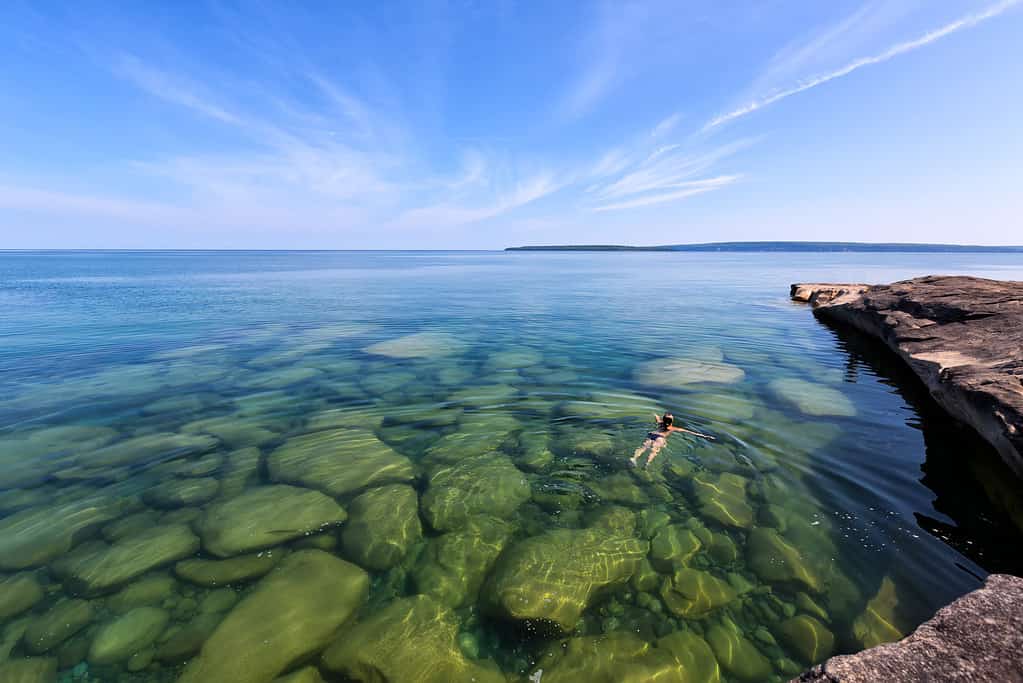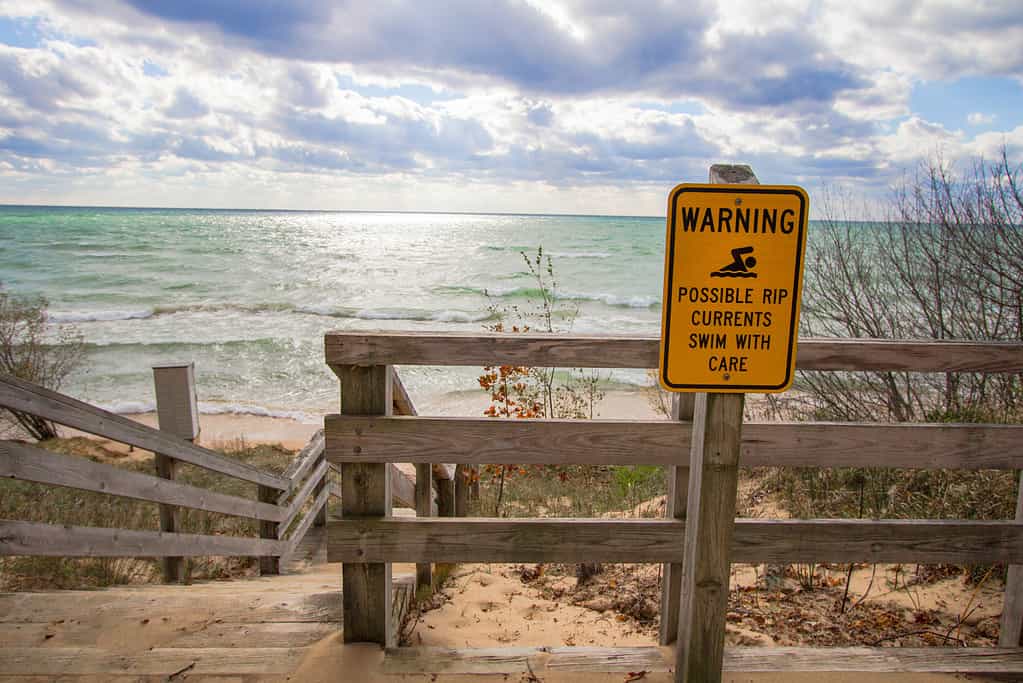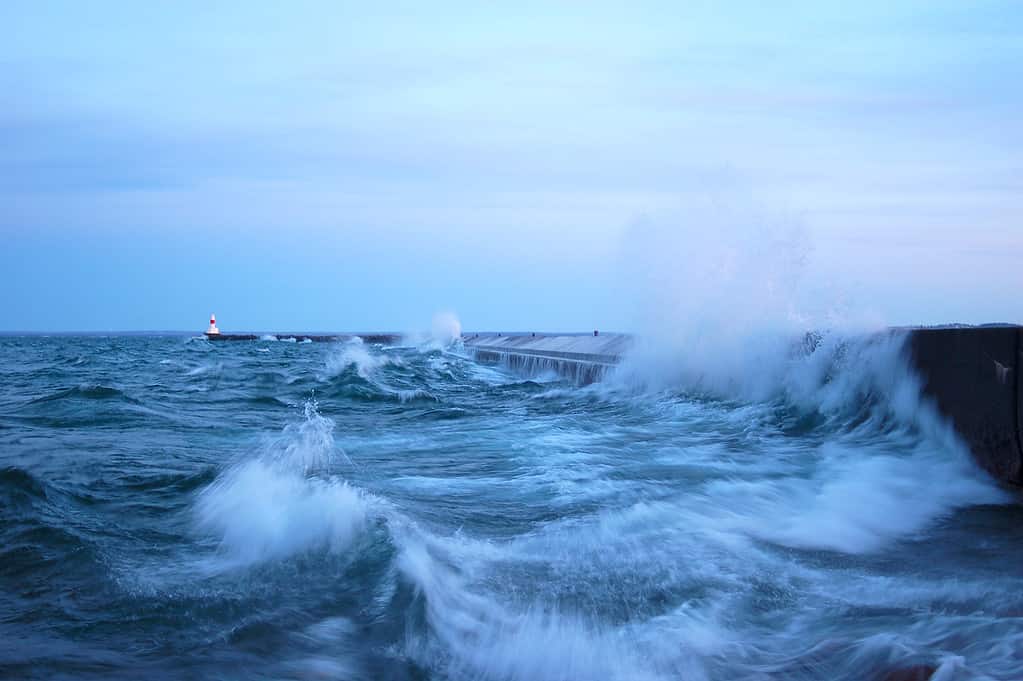
Lake Superior is the largest of the five Great Lakes, and it’s not even close. It would require all the water of the other four Great Lakes combined, plus three additional Lake Eries, to equal the three quadrillion gallons of water that fill Lake Superior. While much of the lake’s nearly 2,800 miles of shoreline is rugged and inaccessible, there are still plenty of places for swimmers to take a dip. But is it safe to swim in Lake Superior?

Lake Superior is a natural wonder, but is it safe for swimmers to take a dip?
©Edgar Lee Espe/Shutterstock.com
Safe to Swim?
Overall, the answer is yes. Lake Superior is safe for swimming. In fact, it has the lowest drowning rate of all the Great Lakes, as reflected in the statistics provided by the Great Lakes Surf Rescue Project. There were 108 confirmed drownings in the Great Lakes in 2022, along with 12 unknown final outcomes. Lake Superior had the fewest drownings by a wide margin.
- Lake Michigan: 45 drownings (+6 unknown final outcome or cause of death)
- Lake Erie: 24 drownings (+4 unknown final outcome or cause of death)
- Lake Ontario: 21 drownings (+1 unknown cause of death)
- Lake Huron: 12 drownings (+1 unknown final outcome)
- Lake Superior: 6 drownings
Some of the statistics are a bit skewed by the number of people who swim in the lakes. Lake Michigan is the most visited of the Great Lakes, so it stands to reason that it would also have the most drownings. However, that is not the only reason it has more drownings than the others. The shape and structure of the lake make it conducive to dangerous currents that often take swimmers by surprise.
Lake Superior has fewer swimmers than the other lakes. It is the most remote of the five Great Lakes. It is also the coldest, which keeps more swimmers out of the water. Still, it is generally the safest lake for swimmers. But that does not mean that it is always safe. Lake Superior can turn dangerous, even deadly, for swimmers. Let’s explore the risks that swimmers need to know.

It is generally safe to swim in Lake Superior, but there are still risks to consider.
©iStock.com/csterken
Sharks? No!
When considering the safety of Lake Superior, this needs to be said loudly, clearly, and unequivocally: there are no sharks in Lake Superior. Despite whatever internet hoaxes and urban legends may say, there are no sharks in any of the Great Lakes. So, while there are legitimate risks to consider when swimming in Lake Superior, a shark attack is not one of them.
In fact, there are no fish of any kind that pose a threat to human swimmers in the Great Lakes.
Pollution
Lake Erie and Lake Ontario are the most polluted of the five Great Lakes. Lake Superior, on the other hand, is the cleanest of the five. It is the most remote of the Great Lakes. There are far fewer people and industries along its shores than the other Great Lakes. There are also virtually no farms to provide fertilizer runoff.
Less development, urbanization, and industrialization mean less pollution in the lake. This has allowed Lake Superior to remain significantly cleaner than the other Great Lakes.
The lake’s massive size also helps it remain clean. Any pollutants that enter the water are diluted far more in Lake Superior than they would be in Lake Erie, for example.
However, the size of Lake Superior also means that any pollutants that enter the water will remain in the lake for many years. The retention time in Lake Superior is far longer than in the other Great Lakes. When a drop of water enters Lake Superior, it will take almost two centuries for that water to flow out of the lake. The retention time is not just true for water, though. It is also true for pollutants. Any contaminants that enter the lake will remain there for a very, very long time.

Lake Superior is the cleanest of the five Great Lakes.
©Elena Elisseeva/Shutterstock.com
Cold Water
One of the more obvious dangers for swimmers, but still one that must be mentioned, is Lake Superior’s cold water. It is the coldest of the Great Lakes with an average water temperature of 36°F. That’s quite a contrast to the 52°F average temperature of Lake Erie, the warmest Great Lake.
The water temperature of Lake Superior does rise significantly in the summer, but even then it can still be pretty darn chilly. That is an important consideration for swimmers.
Cold water drains body heat up to four times faster than cold air. When the human body is immersed in cold water, “cold shock” can cause severe changes in heart rate, blood pressure, and breathing. This creates a much higher risk of drowning than warmer water.
Waves
While Lake Superior is famous for its big waves, most of the time the waves are only one to three feet high. That can certainly change, though. Storms can whip the lake into a frenzy with massive waves of 30 feet!
The 30-foot waves are not much of a concern for swimmers because very few would dare venture into those conditions. It is the smaller to medium-sized waves that pose the greatest risks. Eighty percent of wave and current-related drownings in the Great Lakes happen when the waves are three to six feet high.
The time between waves (wave periods) in the Great Lakes is much shorter than in the ocean. While waves can be 10-20 seconds apart in the ocean, they can come every four seconds in the Great Lakes. This means that, if a swimmer is in the water for 15 minutes, that swimmer has withstood 200 waves. This requires energy and exertion, the full extent of which the swimmer may not even realize. However, if a tired swimmer gets caught in a dangerous current, the danger increases significantly.
Swimmers in Lake Superior need to be aware of the waves and take breaks often. A tired swimmer is a swimmer that is in danger.

The waves of Lake Superior can crash with speed and fury.
©Kenneth Keifer/Shutterstock.com
Dangerous Currents
The greatest risks to swimmers in Lake Superior, and all the other Great Lakes, are the dangerous currents. Water is one of the most powerful forces on Earth. No human being can stand (or swim) against it. Water always wins. There are multiple types of currents that can pose dangers to Lake Superior’s swimmers.

Dangerous currents pose the greatest risk to Lake Superior swimmers.
©ehrlif/Shutterstock.com
Longshore Currents
Have you ever been swimming in a Great Lake or the ocean when you realized that you had drifted 30, 40, 50 yards, or more down the shore from your beach chair? You can thank the longshore current for that.
These currents run along the shore and can be quite strong. If you get caught up in a longshore current, swim directly toward the beach.
Outlet Currents and Rip Currents
An outlet current is created by a river or stream that flows into Lake Superior. There are over 300 streams and rivers that empty into this massive lake, so outlet currents abound.
The water flowing from the river into the lake creates a strong current capable of pushing a swimmer out into deep water.
Rip currents (also called undertow or rip tides) are powerful currents that move away from the shore. While most rip currents flow at one to two feet per second, some flow as fast as eight feet per second.
If you are taken out to deeper water by an outlet or rip current, flip over onto your back so you can float as the current carries you. This may seem counterintuitive, but fighting the current will only tire you out. These currents are short-lived and will dissipate. Once the current dies down, you can swim parallel to the beach to get out of the path of the current. Then swim back to shore at an angle.

The Cross River on the north shore of Lake Superior is a direct tributary of the lake.
©iStock.com/Willard
Channel Currents
These currents flow between an island or other structure and the shore and can be quite powerful. With over 400 islands, there are plenty of places where channel currents can gain strength on Lake Superior.
Because the water has to squeeze through the gap between the island and the shore, the flow of the water speeds up. If you get caught in a channel current, it will not pull you into deeper water but rather parallel to the shore. Float until the current dissipates, and then swim toward the beach.
Because of the potential strength of channel currents, swimmers are strongly advised not to swim between a nearby island and the main shore.

The currents between islands and the main shore can be especially strong.
©Gottography/Shutterstock.com
Structural Currents
The most dangerous currents on the Great Lakes are structural currents. These currents form around structures such as breakwalls and piers.
These currents are always present. The bigger the waves, the more dangerous the structural currents become. Remember that the wave periods are extremely short in the Great Lakes. When one wave crashes, the next one is only a few seconds away. When waves crash into a pier, for example, that wave’s energy is forced back into the water where it collides with the next incoming wave. That creates turbulent conditions that can easily swallow a swimmer.
If you do get caught in a structural current, call for help. Someone on the pier may be able to throw a life preserver (or anything else that floats). Most piers are equipped with ladders, so try to make your way to the ladder. But in reality, there is no safe way to swim around a pier. Even if the water seems calm, the structural currents can be much stronger than they appear.

The waves and currents around piers and breakwalls are the strongest and most dangerous on the lake.
©iStock.com/gregkret
Staying Safe in Lake Superior
Lake Superior is a natural wonder that can be enjoyed safely if visitors remember a few basic safety tips.
1. Check the surf forecast before arriving at the beach. Some localities use a colored flag system, as well. Know what the flag colors mean before getting into the water.
- Green Flag: Low Hazard
- Yellow Flag: Medium Hazard
- Red Flag: High Hazard
- Double Red Flag: Water Access Closed
2. Be honest about your limits. If you are not a particularly strong swimmer or you are not in good physical shape, don’t test yourself. Stay within your limits while in the water.
3. Swim in a group. Lone swimmers are at a significantly greater risk than those in a group.
4. Do not swim around piers or other structures. As discussed above, structural currents can be deadly. Don’t test them.
Following these few basic principles, you can enjoy your time in Lake Superior’s clear, beautiful waters.

Red flags indicate extremely dangerous surf conditions.
©Yakov Oskanov/Shutterstock.com
The photo featured at the top of this post is © iStock.com/troutnut
Thank you for reading! Have some feedback for us? Contact the AZ Animals editorial team.






